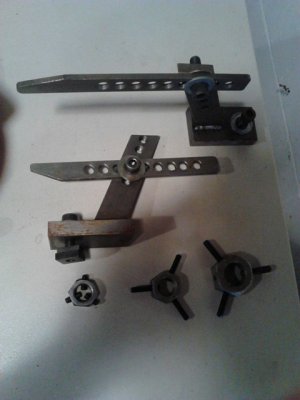Larry, I use whatever length is needed to hold the part. In this sample, notice I had a spool shape to hold, so they needed to be narrow like that. I have others that are longer. There really is no force in torque on the socket cap screws to unscrew them, so really no tendency to turn beyond when you are actually machining the jaws themselves. As they are wrapped around the work very close to the diameter being held, what little tendency to rotate the jaw is counteracted by the leverage arm between the centerline of the jaw along a radian acting against the radian from the spindle centerline to the edge of the contact patch. I find I use this type of jaw fairly often making thin parts. Think washer. Bore, turn, part off.....make as many as needed, then put the jaws on and face to accurate length and be parallel with the first face. They hold the part kind of like an emergency collet would. I get parallelism and TIR errors of a few tenths, typically. And wrapping around the part as much as needed, even thin plastic can be treated this way. I make some thrust bearings out of PEEK, 0.250 +/- 0.001 with this set up. Never lost one yet. I kike the safety of a round jaw too. Doesn't hurt nearly to bad to dust your knuckles as a regular jaw does. As long as you break the edges good on them when you make the rounds to begin with.
But for repeatability, you would need slots for the radial key on the master jaw, and either fit the socket cap screw very closely, or another key, male, offset outboard of the socket cap screw, as that is where the master jaw has it's keyway. Then it gets less convenient. Thus my claim to easy soft jaws. They really work fine. And if you want to put them back close to where they were, you just snug them up against a piece of material that is the same size they were bored to, and they will clock themselves into position. Then tighten the socket caps and skim them true again. I would imagine match marking them to the master jaws would minimize the skim cut on most chucks.
Thanks for bringing this thread back up. I had forgotten to hunt down that factory made replaceable jaw I promised. I'll do that today.


